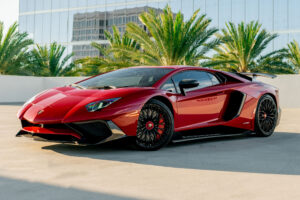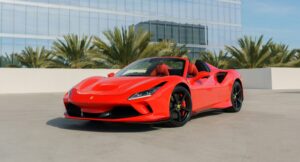Lamborghini, the Italian marque, began its journey in the automotive world in 1963. Ferruccio Lamborghini, an industrialist with a thriving tractor-manufacturing business, established it. The brand was born out of a desire to create grand tourers that could compete with the prevailing titans of the time.
Its headquarters and production facility are in Sant’Agata Bolognese, Italy, a locale integral to the Lamborghini identity.
The company’s history is marked by a series of iconic models defining the supercar’s essence. Throughout its years, Lamborghini has been characterized by its daring design ethos and the pursuit of performance excellence. Often adorned with names that invoke the fighting spirit of a bull—apt for a brand represented by a charging bull logo—Lamborghini’s vehicles have become benchmarks for automotive exuberance and engineering prowess.
In celebration of its 60th anniversary in 2023, Lamborghini entered a new phase in its history. Introducing hybrid technologies signifies the brand’s commitment to futureproofing its legacy while maintaining the distinct characteristics—sculpted designs and formidable powertrains—that have made Lamborghini a staple in sports cars and supercars.
Origins and Founder
This section uncovers the inception of a legendary automotive brand and its visionary founder, Ferruccio Lamborghini, whose passion for engineering and automobiles led to the creation of some of the world’s most iconic luxury sports cars.
Ferruccio Lamborghini and Lamborghini Trattori
Ferruccio Lamborghini was born on April 28, 1916, in Renazzo, Italy. He demonstrated an early aptitude for mechanics and engineering, which steered him away from the agricultural path his family had laid out for him.
After serving as a mechanic in the Air Force during World War II, Lamborghini recognized an opportunity in post-war Italy. He established Lamborghini Trattori in 1948, using the military surplus to build tractors that catered to Italy’s agricultural revitalization. His company flourished, allowing him to indulge in a growing interest in luxury sports cars.
Lamborghini Trattori quickly became one of the leading agricultural equipment manufacturers in Italy. The success of his tractor business provided Lamborghini with the resources and financial stability to pursue his automotive passions.
- Founded: Lamborghini Trattori, 1948
- Location: Cento, Italy
- Founder: Ferruccio Lamborghini
- Specialization: Agriculture machinery and tractors
- Notable Achievement: Utilizing military surplus to address post-war agricultural needs
Birth of Automobili Lamborghini
With a prosperous tractor business and a personal passion for automobiles, Ferruccio Lamborghini set his sights on creating high-end sports cars that could rival established marques like Ferrari. Consequently, he founded Automobili Lamborghini in 1963, positioning it in the small town of Sant’Agata Bolognese, Italy.
The company’s mission focused on producing refined grand touring cars with powerful engines, a bold departure from farming machinery. Ferruccio Lamborghini applied his engineering expertise to develop vehicles that were not just fast but also exhibited impressive technical innovation, luxurious features, and distinctive Italian design.
- Founded: Automobili Lamborghini, 1963
- Location: Sant’Agata Bolognese, Italy
- Founder: Ferruccio Lamborghini
- Focus: Luxury sports cars
- Distinguishing Features: Performance, innovation, luxurious amenities
Iconic Models and Design Evolution
Lamborghini’s history is marked by breakthrough designs and technological advancements shaping the supercar industry. Their iconic models exemplify peak performance and reflect a radical design philosophy.
The Miura – A Revolution in Sports Cars
The Lamborghini Miura, introduced in 1966, set a new standard for sports cars with its mid-engine layout. Engineer Bob Wallace developed it, often hailed as the first true supercar. The Miura’s design was revolutionary, featuring a transversely mounted V12 engine that enhanced its balance and handling.
Countach to Murciélago: Defining the Supercar
The Countach, succeeding the Miura, continued the legacy with its striking and angular design. Unveiled as the LP400 prototype, the Countach maintained the V12 engine but complemented it with futuristic styling. This model line evolved into the Diablo and, later, the Murciélago, which preserved the essence of a Lamborghini supercar—bold, aggressive, and performance-driven.
Modern Marvels: Gallardo to Aventador
In the modern era, Lamborghini introduced the Gallardo with a V10 engine, appealing to a broader audience due to its slightly smaller size yet retaining the brand’s distinctive flair. The Aventador followed, continuing the V12 tradition and incorporating advanced materials and technology. Lamborghini also stepped into the future of sustainable driving with models like the Sesto Elemento and the exploration of hybrid powertrains.
Corporate Milestones
Lamborghini’s corporate history is marked by notable shifts in ownership and strategy and varied financial situations that have shaped the company.
Ownership Changes and Strategic Partnerships
Chrysler Acquisition: 1987 Lamborghini underwent a significant ownership change when the American automobile company Chrysler acquired it. This period under Chrysler marked an attempt to globalize Lamborghini’s brand and expand its product lineup.
Transition to Mimran and Volkswagen AG: Lamborghini faced financial turmoil during the oil crisis of the 1970s, which led to bankruptcy in 1978. The Mimran brothers took charge in 1980 as part of the bankruptcy agreement, revitalizing the company before it was sold to Chrysler. 1998 Lamborghini found stable ground when Volkswagen Aktiengesellschaft took ownership through its Audi division, setting the stage for successful models and technologies.
Financial Successes and Challenges
Struggle and Bankruptcy: Lamborghini experienced severe challenges during the 1970s oil crisis, which contributed to the company’s bankruptcy in 1978. This financial crisis indicated the brand’s vulnerability to global economic fluctuations and underscored the need for a resilient business strategy.
Volkswagen AG Era: Under Volkswagen AG, with Audi at the helm, Lamborghini’s headquarters remained in Sant’Agata Bolognese and witnessed substantial investments. This era has been marked by financial successes, displaying the brand’s resurgence and sustained growth in the high-performance luxury car market.
Lamborghini in the Modern Era
Lamborghini’s journey through the modern era is distinguished by remarkable engineering feats and bold diversification, notably in performance supercars and the luxury SUV market.
Advanced Engineering and the Push for Performance
Pursuing performance has long been at the heart of Lamborghini’s ethos. Advanced engineering techniques have created some of the fastest and most powerful vehicles in the sports car segment.
The Lamborghini Miura set a high standard for performance with its rear mid-engine and rear-wheel drive layout. This tradition of innovation is carried forward with models like the LP 580-2 and the Performante, both boasting enhancements that refine speed, agility, and aerodynamics.
- LP 580-2: A rear-wheel drive variant that underscores a pure and thrilling driving experience.
- Performante: Integrated advanced aerodynamics, featuring Lamborghini’s Active Aerodynamics (ALA) system for increased downforce and improved performance.
Expanding Market with SUVs and Limited Editions
Lamborghini ventured into SUVs with the Urus SUV in an astute response to broadening market appetites.
This move leveraged the brand’s reputation for luxury and performance and translated it into a versatile and practical package.
The Urus quickly became a pivotal model in Lamborghini’s lineup, offering a unique SUV utility and supercar DNA mix.
Lamborghini has also created a series of limited-edition models to celebrate milestones and showcase their technical prowess.
The Centenario, for instance, honored the 100th anniversary of founder Ferruccio Lamborghini’s birth.
These limited editions are testaments not only to Lamborghini’s rich heritage but also to its constant quest for innovation and setting new benchmarks in the automotive industry.
- Urus SUV: Combined high-performance engineering with the practicality of an SUV, redefining its market segment.
- Centenario: A limited edition supercar with a highly tuned V12 engine exemplifies Lamborghini’s commitment to innovation.

